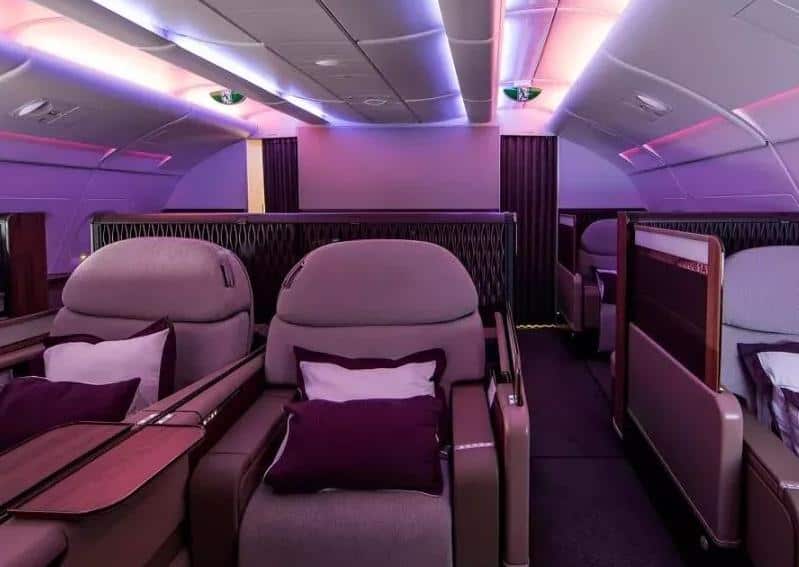The curtain separating first and economy class symbolizes the differences in comfort, food, and service in the cabin. The cabin crew and passengers already know where each class is located, so why does first class have a separating curtain?
First class has a separating curtain to give first-class passengers privacy, peace, and quiet. It’s also a physical barrier between first and economy class to discourage economy class passengers from using first-class facilities. The FAA requires planes to have separating curtains.
In this article, I’ll explain in-depth why first class has a separating curtain and if it’s worth flying first class.
Do We Need a Curtain Between First and Economy Class?
There is nothing more disheartening for an economy class passenger than to see the flight attendant close the curtain between first and economy class. So, why do airlines have a curtain separating classes?
We need a curtain between first and economy class because first-class passengers expect a private and quiet flight. Since first class passengers pay extra for this privilege, the expectation of greater privacy creates the need for a separating curtain between the classes.
Despite what many passengers believe, airlines don’t have a separating curtain to make economy passengers feel inferior and consider flying first class next time.
Let’s take a look at these reasons for the separating curtain in more detail below:
Privacy for First Class Passengers
When flying economy class, there’s not a lot of privacy since the seats are closely packed. However, in first class, passengers can keep to themselves and enjoy a peaceful and quiet flying experience.
The first-class separating curtain protects the privacy of first-class passengers by preventing other passengers from looking at them and discouraging them from moving through the first-class cabin.
Instead of using private jets, some high-profile executives and celebrities fly first class in a commercial plane. The separating curtain helps maintain their privacy and allows them to enjoy a flight without fans or other passengers bothering them.
Creates a Barrier Between First and Economy Class Facilities
If you’ve ever compared the prices of first, business, and economy class flight tickets, you’ll notice a vast difference. Business-class tickets can be three times as expensive as economy class tickets, while first class can cost twice as much as a business class ticket.
When paying a huge amount for an air ticket, you expect a luxurious flight, including delicious food and access to the lavatory without having to line up. The lack of a separating curtain would tempt some economy class passengers to stretch their legs in the first-class section and use the first-class lavatory, irritating first-class passengers who’ve paid a fortune for the flight.
FAA (Federal Aviation Authority) guidelines stipulate that airlines must have one flight attendant for fifty passengers. Airlines typically have this flight attendant to passenger ratio in economy class. However, this ratio is much higher in first class, as first-class passengers expect excellent service.
Without the separating curtain, economy-class passengers would distract the flight attendants and divert their attention from first-class passengers.
The FAA Requires Planes To Have a Separating Curtain
After the horrific events of 9/11, the FAA required separating curtains between classes to be removed so that air marshalls and flight attendants could monitor passenger movements more closely.
However, the FAA has since scrapped this regulation and now requires airlines to have separating curtains once again. The main reason behind this is to reduce the number of passengers around the cockpit, which could be a security risk.
This regulation also prevents passengers from congregating in a particular area, which is also a security risk.
Is It Worth Flying First Class?
A common gripe with economy class passengers is that, when boarding, they must move through the first-class cabin to get to their seats. This makes them feel disappointed and worried about their tiny economy class seats. So, is it worth the money flying first class?
It is worth flying first class if your flight is very long, you’re using air miles, or you have an injury or medical condition that requires you to stretch out. It might also be worth it if you’re traveling for a once-in-a-lifetime trip.
I’ll discuss whether or not first class is worth it below in more detail:
Your Flight Is Very Long
On short-haul flights of less than five hours, airlines often use smaller aircraft where there’s very little difference between first and economy class. In such cases, it’s not worth splurging on a first-class ticket for better pretzels or priority boarding.
However, if you’re traveling to the other side of the world, and your flight will be very long, it might be worth buying a first-class ticket. Many airlines have scheduled flights longer than seventeen hours, and flying first class can make your flight a much more enjoyable experience.
Being able to stretch your legs and move around the cabin more freely can help you arrive at your destination feeling fresh.
Flying first class also often involves other extras:
- Limousine transfers to and from the airport
- Concierge check-in with no lines
- Access to the first class lounge, which often includes spa treatments, like pre-flight massages and manicures
- Joining the express line through security
- Receiving high-end toiletries and accessories
- Extra luggage allowance
- Showers, ambient lighting, and choosing when to eat on-board
You’re Using Air Miles
Flying first class is too expensive for many people, and most travelers would instead put the money toward another trip abroad or stay at a luxury hotel.
However, if you’re a frequent flier and have accumulated many air miles, you might consider using them for a first-class flight. In such cases, using air miles instead of money to pay for a first-class flight might be worth it.
You Have an Injury or Medical Condition
Travelers who have had a recent injury or a medical condition that requires them to stretch out and move around often might find it medically necessary to book a first-class ticket.
Below are some examples of where a first-class ticket could benefit your health:
- You’ve broken your leg or ankle and need to keep it elevated.
- You’re prone to deep vein thrombosis or extreme leg and foot swelling when you sit in the same position for too long.
- You have claustrophobia.
People who are very tall or obese may find that an economy class seat is too restrictive. While booking two economy class seats or selecting an aisle or emergency exit seat may be an option, they may find first class far more comfortable.
Once-in-a-Lifetime Trip
If you’ve always dreamed of traveling to a certain destination and finally saved up enough money, it might be worth splurging on a first-class ticket to make the trip extra special.
Once-in-a-lifetime trips often warrant a first-class air ticket, and examples include:
- Golden wedding anniversary celebration trip
- Honeymoon
- Flying back home after performing a difficult challenge (e.g., climbing Mount Everest or cycling across a continent)
- Flying to or from a religious pilgrimage (e.g., going to Lourdes, Jerusalem, Mecca, or the Vatican City)
You Need To Work During the Flight
If you’re traveling for business and you need to work during your flight, you might have difficulty working when flying economy class. If the passenger in front of you has reclined their seat, your laptop might not fit correctly on your tray table, and you’ll have limited space to work.
Being in a first or business class seat allows you more room to work, a quieter space to focus, and fewer distractions. Additionally, you won’t have to worry about people looking over your shoulder while you try to get some work done.
If first class doesn’t sound right for you, in this article I talk about whether or not economy plus seats are worth the upcharge.
Final Thoughts
The separating curtain between first and economy class is not to make economy class passengers feel bad. Instead, it ensures that first-class passengers get value for money by having a quiet and luxurious flight.
It prevents economy class passengers from entering the first-class cabin, keeping the lavatories and aisles clear for first-class passengers.
The FAA also requires all American aircraft to have a separating curtain between classes.
Sources
- Quora: Why is there a curtain between first class and cattle class?
- Federal Aviation Administration: Homepage
- Pegasus: Economy Class
- Conde Nast Traveler: Why Airline Concierges Are Hidden Heroes for Frequent Fliers
- Cornell Law School: Flight Attendant Requirements



